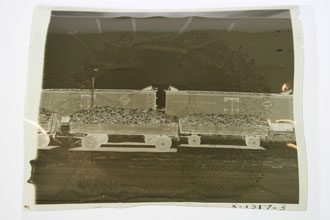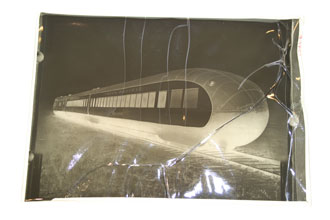Digitizing Union Pacific’s Past

1937 image of a Pacific Fruit Express train full of lettuce at Salinas, Calif. The rippled quality of the image, the channeling of the emulsion and the warping of the negative are all symptoms of deterioration common in cellulose acetate negatives.
Union Pacific Railroad Museum has embarked on a multi-year effort to digitize much of Union Pacific’s historic photograph collection. The Museum’s collection of more than 500,000 images provides a record of American photography dating back to the 1860s. Union Pacific continues this legacy today by documenting the progress and expansion of the railroad across a 23-state region and roughly 32,000 miles of track.
The history of photography dates back to 1839 when Louis Daguerre patented the process of the daguerreotype – an image placed directly on a mirrored metal surface. Almost immediately, photographers discovered these images were incredibly fragile, so the race was on to discover a more stable form of photography. Technology advanced through ambrotypes (images on glass) to tintypes (images on tin) to processes that involved the creation of photographic negatives. It was with glass negatives that Union Pacific’s early history was first recorded. The process of using, first wet plate negatives and then dry plate negatives, continued into the 20th Century and Union Pacific’s own photo department adopted these practices in the 1930s. Glass negatives are fragile, but if treated with care and stored properly, the images captured can last lifetimes.

Advances in scanning and digitizing technology make it possible for these images to be captured and preserved before they are lost. Through the Museum’s digitization project, its most valuable photographic resources will be scanned and cataloged while the precious originals will be restored to proper containers and conditions to hopefully last the next 100 years.
The next evolution of photography was more problematic. While the development of film revolutionized photography, it presented a new set of challenges for preservation. After the 1930s, much of Union Pacific’s history was captured on cellulose-based film. These films captured amazing detail and were used by Union Pacific to record and advertise the heyday of passenger travel, and the expansion of the Union Pacific system. This film, however, does not last forever and is extremely susceptible to changes in environment. This fragility can often cause images to be completely lost from their negatives. Later slide film can also deteriorate, with colors turning from vibrant to a murky brown.
Advances in scanning and digitizing technology make it possible for these images to be captured and preserved before they are lost. Through the Museum’s digitization project, its most valuable photographic resources will be scanned and cataloged while the precious originals will be restored to proper containers and conditions to hopefully last the next 100 years.

